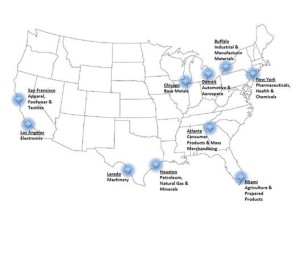CBP streamlining its services to businesses with its centers of excellence
Customs and Border Protection is streamlining its services to businesses by centralizing its import operations in 10 Centers of Excellence and Expertise.

Customs and Border Protection is streamlining its services to businesses by centralizing its import operations in 10 Centers of Excellence and Expertise.
Before CBP started creating these centers in 2012, importers had over 60 ports of entry to choose from, and would have dealt with different CBP officers and administrators at each one.
“Now, they’ll work with one of the 10 centers, and that center will be their central point of contact for their trade and post-release activities,” Susan Thomas, acting director of trade operations at CBP, told the Federal Drive with Tom Temin. “So rather than deal with 60 ports of entry, they’re dealing with one center and they’re going to get consistent, uniform, predictable decision-making from CBP.”

Each of the 10 centers focuses on a different industry.
The personnel at each center work with on-site CBP staff to provide support in examining shipments entering the country and determining levels of risk, according to Thomas. They also collaborate with laboratory workers to match sample inventory to established brand and trademark information to determine the legitimacy of products entering the country.
“Whether it’s the clothes you’re wearing, the car you’re driving, the flowers you bought your spouse or the toys your children are playing with, if they were imported, our personnel in these centers ensure that the proper duties were collected and that the products do not pose serious health and safety hazards,” Thomas said. “In addition, they play a very important role in ensuring that counterfeit and pirated products don’t enter the U.S. commerce, because those products threaten our economic security by hurting legitimate businesses who invest significant amounts to protect their brand.”
She said that CBP officers at the centers consider a number of factors when determining the risk of allowing shipments into the country, including country of origin, history of non-compliance, and the identity of both shippers and importers.
“We want to ensure that we allow the legitimate cargo to flow freely into the country while we work to ensure that any illicit cargo is detained and eventually possibly not enter into the country,” Thomas said.
Soon, CBP’s automated commercial environment (ACE) will streamline this whole process even more by virtually linking all the disparate parts of the operation.
“We fully expect, by the end of Dec. 2016, ACE will be fully deployed for all aspects of the trade process,” Thomas said. “It aligns with our centers perfectly. This allows us to move work virtually to our staff, and move work more quickly so that the trade has a more responsive answer from us.”
Copyright © 2025 Federal News Network. All rights reserved. This website is not intended for users located within the European Economic Area.
Daisy Thornton is Federal News Network’s digital managing editor. In addition to her editing responsibilities, she covers federal management, workforce and technology issues. She is also the commentary editor; email her your letters to the editor and pitches for contributed bylines.
Follow @dthorntonWFED
Related Stories
Austin failed to tell Congress or the White House about his health problems as required, report says






